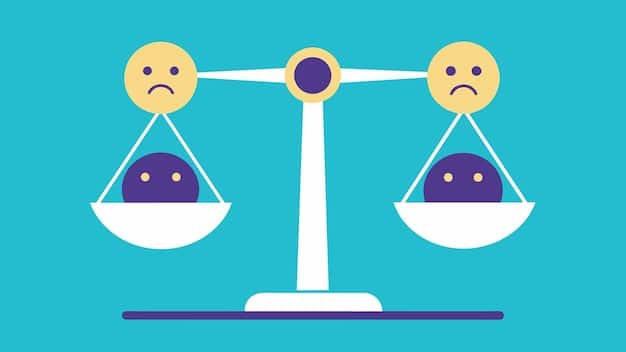Identify & Challenge Negative Thoughts: A CBT Approach

Identifying and challenging negative thought patterns using Cognitive Behavioral Therapy (CBT) involves recognizing distorted thought processes and employing techniques to reframe them into more balanced and realistic perspectives, fostering improved mental well-being and emotional resilience.
Do you ever feel trapped in a cycle of negative thoughts? **How to Identify and Challenge Negative Thought Patterns: A Cognitive Behavioral Therapy (CBT) Approach** offers practical strategies to break free and cultivate a healthier mindset.
Understanding Negative Thought Patterns
Negative thought patterns can significantly impact our mental and emotional well-being. Recognizing these patterns is the first step towards managing them effectively.
These patterns often manifest as automatic negative thoughts (ANTs) that pop into our heads without conscious effort. Understanding their origins and impact is vital for developing coping strategies.
Common Types of Negative Thought Patterns
Several common negative thought patterns can distort our perception of reality. Being aware of these patterns allows us to identify and challenge them more effectively.
- Catastrophizing: Assuming the worst possible outcome in every situation.
- Overgeneralization: Drawing broad conclusions based on a single event.
- Personalization: Believing that everything others do or say is a direct reaction to you.
- Black-and-White Thinking: Seeing things in extremes, with no middle ground.
Once we recognize these patterns, we can begin to examine the evidence supporting and contradicting these thoughts. This process helps us to develop more balanced perspectives.

The Cognitive Behavioral Therapy (CBT) Approach
Cognitive Behavioral Therapy (CBT) is a structured approach to identifying and changing negative thought patterns. It focuses on the connection between thoughts, feelings, and behaviors.
CBT provides tools and techniques to challenge negative thoughts and replace them with more positive and realistic ones, leading to improvements in mental well-being.
Core Principles of CBT
CBT operates on several core principles that guide its therapeutic process. Understanding these principles is essential for applying CBT techniques effectively.
- Identifying Negative Thoughts: Recognizing and documenting negative thoughts as they arise.
- Challenging Thoughts: Evaluating the evidence for and against negative thoughts.
- Reframing Thoughts: Replacing negative thoughts with more balanced and realistic alternatives.
- Behavioral Experiments: Testing the validity of negative thoughts through real-world experiences.
By adhering to these principles, CBT helps individuals develop lasting strategies for managing negative thought patterns and improving their overall mental health.
Techniques for Identifying Negative Thoughts
Identifying negative thoughts is the crucial first step in implementing a CBT approach. Several techniques can help bring these thoughts to conscious awareness.
Thought records, mindfulness practices, and identifying cognitive distortions are effective methods for uncovering and documenting negative thought patterns.
Thought Records
Thought records are structured tools for tracking and analyzing negative thoughts. They typically include columns for the situation, the negative thought, associated feelings, and alternative, more balanced thoughts.
Using thought records consistently can help individuals become more aware of their negative thought patterns and develop more objective perspectives.
Mindfulness Practices
Mindfulness practices involve paying attention to the present moment without judgment. This can help individuals become more aware of their thoughts and feelings as they arise.
Mindfulness techniques, such as meditation and deep breathing, can create space between individuals and their thoughts, allowing them to observe negative thoughts without immediately reacting to them.
Challenging Negative Thoughts
Challenging negative thoughts involves questioning their validity and examining the evidence supporting and contradicting them. This process helps to develop more balanced perspectives.
Techniques such as the Socratic questioning and the “Evidence Evaluation” method are effective for challenging negative thoughts objectively.
Socratic Questioning
Socratic questioning involves asking a series of questions to explore the underlying assumptions and biases in negative thoughts. These questions encourage critical thinking and can reveal flaws in the logic of negative thoughts.
Example questions include: What evidence do I have to support this thought? What evidence do I have against this thought? Is there another way to interpret the situation?
Evidence Evaluation
The evidence evaluation method involves systematically listing the evidence for and against a negative thought. This process helps individuals to assess the validity of their thoughts objectively.
By examining the evidence both for and against, individuals can often see that their negative thoughts are not entirely accurate or justified.

Reframing Negative Thoughts
Reframing negative thoughts involves replacing them with more balanced and realistic alternatives. This process can lead to significant improvements in emotional well-being.
Two techniques for reframing include identifying cognitive distortions and generating alternative, more positive thoughts.
Identifying Cognitive Distortions
Cognitive distortions are patterns of thinking that are biased or inaccurate. Identifying these distortions is crucial for reframing negative thoughts effectively.
Common cognitive distortions include catastrophizing, overgeneralization, and black-and-white thinking. Recognizing these distortions allows individuals to challenge their validity and develop more balanced perspectives.
Generating Alternative Thoughts
Generating alternative thoughts involves coming up with different, more positive or realistic interpretations of a situation. This can help to reduce the impact of negative thoughts and improve emotional well-being.
- Consider the best-case scenario: What is the most positive outcome that could result from this situation?
- Look for the silver lining: What positive aspects can be found in this situation?
- Challenge assumptions: Are there alternative explanations for what happened?
By actively generating alternative thoughts, individuals can break free from negative thinking patterns and develop more optimistic and realistic perspectives.
Maintaining Progress and Preventing Relapse
Maintaining progress and preventing relapse are essential for long-term success in managing negative thought patterns. Consistent practice and continued self-awareness are key factors.
Developing a maintenance plan, seeking ongoing support, and practicing self-compassion are effective strategies for sustaining positive changes and preventing relapse.
Developing a Maintenance Plan
A maintenance plan involves outlining specific strategies and practices for continuing to challenge negative thoughts and maintain a positive mindset. This plan should include regular use of CBT techniques and ongoing self-monitoring.
Regular check-ins, journaling, and continued mindfulness practices can help individuals stay aware of their thoughts and feelings and address any emerging negative patterns proactively.
Seeking Ongoing Support
Seeking ongoing support from friends, family, or a therapist can provide valuable encouragement and guidance in maintaining progress and preventing relapse. Support groups and online communities can also offer a sense of connection and shared experience.
Having a support system in place can help individuals navigate challenges and setbacks and stay committed to their goals for managing negative thought patterns.
| Key Point | Brief Description |
|---|---|
| 💡 Identify Negative Thoughts | Recognize patterns through thought records and mindfulness. |
| 🤔 Challenge Thoughts | Use Socratic questioning and evidence evaluation. |
| 🔄 Reframe Thoughts | Replace negative thoughts with balanced alternatives. |
| 🛡️ Maintain Progress | Develop a maintenance plan and seek ongoing support. |
Frequently Asked Questions (FAQ)
▼
CBT is a type of psychotherapy that helps people identify and change negative thinking patterns that can contribute to emotional distress. It focuses on the connections between thoughts, feelings, and behaviors.
▼
You can identify negative thought patterns by keeping a thought record, practicing mindfulness, and paying attention to the types of thoughts that trigger unpleasant emotions. Journaling can also be helpful.
▼
Common cognitive distortions include all-or-nothing thinking, catastrophizing, overgeneralization, personalization, and emotional reasoning. Recognizing these distortions is crucial for challenging them.
▼
You can challenge negative thoughts by questioning the evidence supporting them, asking yourself if there are alternative explanations, and considering the consequences of believing these thoughts.
▼
Ideally, you should practice CBT techniques daily or several times a week. Consistent practice is key to reinforcing new thinking patterns and maintaining progress in managing negative thoughts.
Conclusion
By understanding and applying the principles of CBT, you can effectively identify and challenge negative thought patterns. This process empowers you to cultivate a more balanced and positive mindset, leading to improved mental and emotional well-being.





